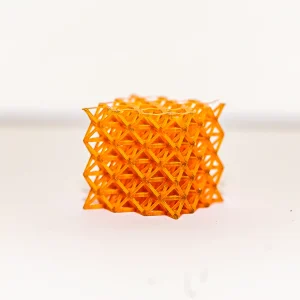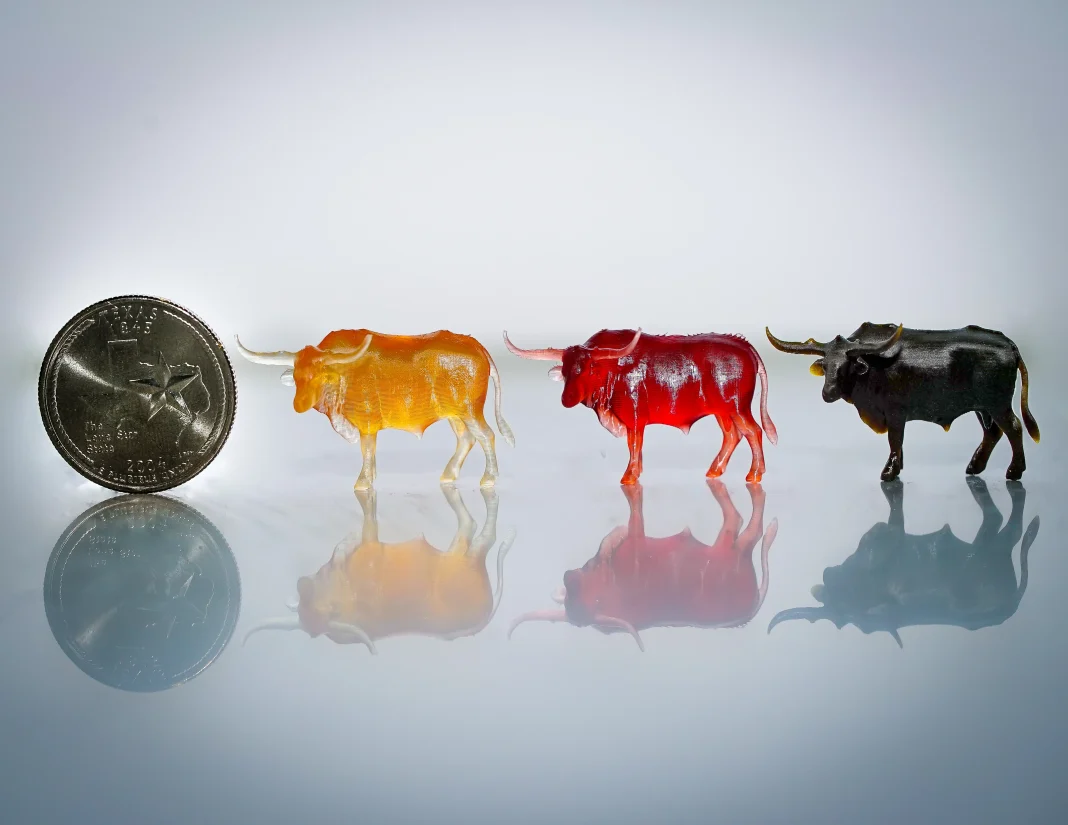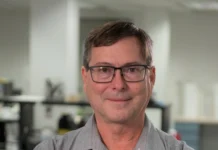By Liz Stevens, writer, UV+EB Technology
The research team headed by Prof. Zachariah Page, assistant professor in the Department of Chemistry at The University of Texas at Austin, earned a 2021 RadLaunch Award for “Multi-Color Visible Light Additive Manufacturing.” Page’s team is developing high-resolution stereolithographic 3D printing using different colors of low-energy visible light to rapidly solidify resins and also is formulating panchromatic photopolymer resins for the process.
Page and his team of graduate students and post-docs – which includes Marshall Allen; Henry Cater; Kun-You Chung; Meghan Kiker; Keldy Mason; Connor O’Dea; Adrian Rylski; Alex Stafford; Lynn Stevens; and Jinwon Seo, Ph.D. and Hu Wang, Ph.D. – perform research on light-driven polymerization reactions, including developing catalysts that operate within the visible light spectrum and creating functional plastics. The group is especially focused on using the precision of light-based chemistry to control when and where chemical reactions occur.
Page explained the impetus for the current research. “We wanted to think about translating traditional light-based 3D printing technologies into something with unique opportunities,” said Page. “We settled on the concept of shifting the spectrum from the traditional wavelengths of light – higher energy ultraviolet wavelengths – into the visible and near-infrared wavelengths.” Page and the team were curious about using visible light to apply specific colors – and thus specific amounts of energy – during 3D printing. “By doing that, we hoped to activate different chemical processes, which then would give us control over imbuing a final printed part with discrete material properties.”
The team was interested in activating and combining radical, cationic, anionic and metathetic chemical processes for curing acrylic resins and epoxies, and for formulating urethanes, polysulfides and polyolefins with versatile mechanical properties. “Some of the types of structures that we were targeting were composites – such as plastics with fillers that will absorb or scatter UV – and water-swollen gels that, via different colors of light, might be fabricated with a gradient of stiffness.” Page also sought to experiment with multi-functional materials, such as one object that contains two components of different polarities or cross-link densities, which would enable variability in how the components swell and take shape upon exposure to solvent.
 The first task toward the team’s goal was to build a 3D printer that included red, green and blue (RGB) light alongside the traditional UV/violet at approximately 400 nm. With the help of computer hardware manufacturer MonoPrinter, Allston, Massachusetts, a customized printer was put together featuring red, green and blue LEDs in addition to UV/violet. The printer included controls for the projected color, its intensity, the exposure time per layer, the layer thickness and also the atmosphere of the print chamber. Page et al. tested the RGB LEDs and found that the emission profiles showed clean wavelength measurements, giving the team a basis for mixing and matching color to activate different chemical processes during a 3D print build. While the printer is similar to typical stereolithography printers, which use a laser to draw a point-by-point slice, Page’s printer uses a projector that allows a print slice to be projected and cured as a whole.
The first task toward the team’s goal was to build a 3D printer that included red, green and blue (RGB) light alongside the traditional UV/violet at approximately 400 nm. With the help of computer hardware manufacturer MonoPrinter, Allston, Massachusetts, a customized printer was put together featuring red, green and blue LEDs in addition to UV/violet. The printer included controls for the projected color, its intensity, the exposure time per layer, the layer thickness and also the atmosphere of the print chamber. Page et al. tested the RGB LEDs and found that the emission profiles showed clean wavelength measurements, giving the team a basis for mixing and matching color to activate different chemical processes during a 3D print build. While the printer is similar to typical stereolithography printers, which use a laser to draw a point-by-point slice, Page’s printer uses a projector that allows a print slice to be projected and cured as a whole.
Then came the process of creating resins with the chemistries necessary to react to different colors of light. “We turned to what we call a photochemical toolbox,” said Page. The researchers examined different photoredox active materials that can take in light and convert it through electron transfer to initiate polymerization, and they identified some commercial catalysts as a starting point. “The biggest thing that we did from there,” said Page, “was to identify how we could take those photoredox active compounds and convert them into being catalytic in nature so we could use small amounts of the compounds but still enable very rapid polymerization.” The key, he explained, was to identify co-initiators – an acceptor iodonium species and a donor borate species – that would kick off a catalytic process, absorbing the different wavelengths of light and rapidly turning over to generate radicals for acrylate types of curing. Testing proved that with all four of the systems – UV/violet, red, green and blue – curing of standard acrylic resins could be achieved with under 10 seconds of exposure to relatively low intensity (five milliwatts per centimeter squared, which is less than a commercial laser pointer).
The team’s next step was to use its custom 3D printer to demonstrate the feasibility of doing layered assembly of these materials and to determine the highest resolution that could be achieved. Page and his researchers optimized the exposure time per layer and, in a test, the process was applied at two to three milliwatts per centimeter squared and at 11 seconds of exposure per layer. The resulting prints showed good resolution for printed features measuring 80 microns by 80 microns.
“The other thing that we wanted to confirm,” said Page, “was that by using different wavelengths, we would not be altering the material properties and, in particular, the mechanical properties.” The team demonstrated that by using different wavelengths, but using the same resin, apart from the photosystem, they were able to create materials with very similar mechanical properties. It worked with hard plastics, and the effect was not specific to a particular acrylate resin; the researchers used a variety of different acrylics, including those that produced a stiff, brittle material, as well as a soft, extensible material.
To really put the process to a test, Page printed a complex octet truss and then used scanning electron microscopy to confirm the high fidelity and fine resolution (sub-hundred micrometers) of the image on the 3D object.
Page and the team found that the presence of oxygen slowed the process down and that an atmosphere of inert gas in the build chamber allowed for the highest cure speeds. “We wanted to remove the need for inert gas in order to make this more user-friendly and commercially relevant,” Page said, so the group considered how to introduce a new type of chemistry to alleviate the need for the removal of oxygen and the use of an inert gas. “What we discovered was that adding just a small amount of a multi-functional thiol component could completely mitigate the oxygen inhibition period. At even just 1% of a thiol-reagent, we are able to cut the time to gelation in more than half and then remove the inhibition completely if we moved to higher contents of thiol.” Since the thiol, when used in higher amounts, affected the material properties of the base resin, a delicate balance had to be struck to achieve fast polymerization while maintaining the desirable material properties of the acrylic resins. Achieving that delicate balance yielded a secondary benefit: higher resolution which, at the sub-50 microns level, approached the maximum resolution of the printer itself.
With a visible light 3D DLP printer built and an arsenal of proven resins, photoinitiators, co-initiators and catalysts now in hand, Page looks forward to exploring multi-color printing by combining wavelengths and applying the combinations to resins containing multiple chemical compositions. “We will have the capability to perform simultaneous exposure of multiple wavelengths of light,” said Page, to tap the type of radical, cationic, anionic and metathetic chemistries already mentioned. “One can imagine that combining some amount of different colors of light can equate to combining some amount of the different material properties that result from each colored exposure, enabling the production of 3D printed parts with gradient properties,” said Page. This would bring us one-leap closer to 3D printing being only limited by our imagination.
For more information on this research, visit https://zpagegroup.com.
RadTech, the nonprofit for UV+EB, celebrated the 2021 RadLaunch Award winners during an Awards Zoom Program on April 28, 2021. RadTech’s RadLaunch Committee selects award winners among end users of the technology, based on new, promising and/or novel use of UV and/or EB.







